- Revenue Cycle Management
- COVID-19
- Reimbursement
- Diabetes Awareness Month
- Risk Management
- Patient Retention
- Staffing
- Medical Economics® 100th Anniversary
- Coding and documentation
- Business of Endocrinology
- Telehealth
- Physicians Financial News
- Cybersecurity
- Cardiovascular Clinical Consult
- Locum Tenens, brought to you by LocumLife®
- Weight Management
- Business of Women's Health
- Practice Efficiency
- Finance and Wealth
- EHRs
- Remote Patient Monitoring
- Sponsored Webinars
- Medical Technology
- Billing and collections
- Acute Pain Management
- Exclusive Content
- Value-based Care
- Business of Pediatrics
- Concierge Medicine 2.0 by Castle Connolly Private Health Partners
- Practice Growth
- Concierge Medicine
- Business of Cardiology
- Implementing the Topcon Ocular Telehealth Platform
- Malpractice
- Influenza
- Sexual Health
- Chronic Conditions
- Technology
- Legal and Policy
- Money
- Opinion
- Vaccines
- Practice Management
- Patient Relations
- Careers
Pismo Beach, CA: Beaches and Butterflies
Sand dunes, butterflies, and film industry "artifacts" highlight a trip to Pismo Beach and Oceano. The coastal region offers a range of activities, history lessons, and good food.
Before us is not the entire coast of North America but it seems like it; California is that big. And its highways are busy. This is not the possible pursuit of pleasure along interstates in remote parts of Texas or Nebraska. This is Commuter Territory and, to a degree, one could argue there’s always someplace in California that’s having its Rush Hour.
So if you live in San Diego, as close as any US city is to the Mexican border, you don’t putter on any planned excursion to Pismo Beach, you move right along. You pass farms with flat fields and old JC Penney stores and deserted and perhaps derelict high schools and electric pylons and simple homes like any in rural America and open terrain not blocked by trees, a bit like lower Vermont. You pass golf courses and horse stables and fields with workers bent over cauliflowers and you blow past Guadalupe thinking you might have crossed the border into Mexico but the signs suddenly say “California Welcome Center Pismo Beach” and you have arrived on Highway 1 at what the state calls The Central Coast: The Original Road Trip.
We came to Pismo Beach differently from our usual. A failure of travel writers is they sometimes have things over-organized and arrive at destinations over-prepared so nothing is a surprise, nothing is fresh. They could almost write the article without making the visit. Pismo was different. We arranged the hotel first because it’s a popular town especially at the start of spring and it would have been a long drive to come without a hotel reservation.
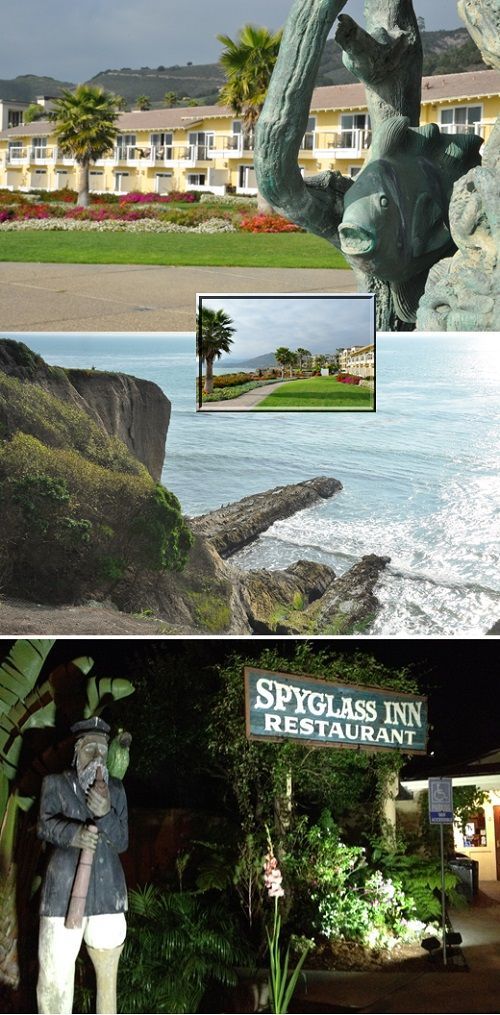
So apart from nailing down the Spyglass Inn we had nothing planned for our 2 days in town. We used the internet for ideas finding where the beaches were and which hotels had an ocean location, then saw what some of the social media thought of the different hotels. Some hotels were cagey about quoting a room rate but the mid-priced Spyglass Inn boasted it was atop the ocean front cliff bluffs and it had a restaurant on site so it was perfect.

The Seaside Café and Bakery. The Fish and Chips Restaurant. A downtown café.
We ate well in Pismo Beach. We found the Seaside Café and Bakery a 5-minute drive from the inn with great Illy-brand coffee and marvelous genuinely made, somewhat pricey, granola. We ate there twice. We had lunch downtown in a seafood restaurant with the exciting name of “Fish and Chips Restaurant” that was established in 1962 by the Dutch Zechner family. They had emigrated from Holland in 1959 and were eking out a living with a small fish retail market when Jack Zechner, a house painter, found a wallet on the street containing $900. He called the owner and returned it declining any reward. The owner was a local bank president who later was pleased to lend money to a family of hard-working honest people who wanted to open a restaurant! The family has just sold the restaurant after 23 years. We hope the new owners leave the menu alone and the mural on the wall as it is also.

The beach slopes gradually to the sea at downtown Pismo Beach. The pier gives an old-fashioned buzz to the families having fun on the sand, and the sun and the simplicity of the beach scene probably gives warmth, too, to the couple getting married.
The big sand dunes in Oceano, a 15-minute drive to the south, are the most extensive along the Californian coast and many are “the largest sand dunes in the world.” A 1906 newspaper article refers to a rally on the beach between Ford’s northern and southern car dealerships so the dunes have a history beyond that of the Chumash who have left “middens” of shells after they were eaten for food. The state has now created an 18-mile-long vehicular recreational area with 3,600 acres of rolling dunes including even a sand highway. We had arranged for a dune ride there but it started to rain heavily and Pacific Adventure Tours couldn’t go out on the dunes and get their open Hummers soaking wet.
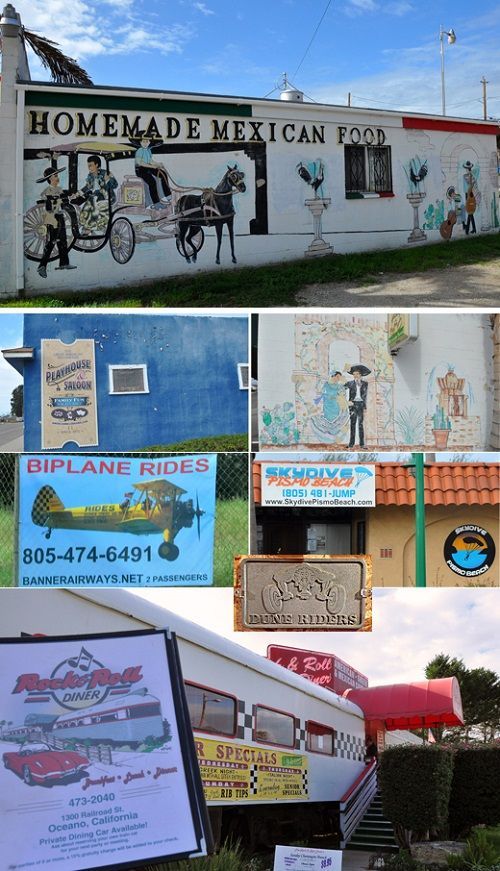
Activities along the dunes include tours by rented bicycle or dune buggy, or you can hike and enjoy the trails on horseback. You can take surf lesson, too, or go kayaking. Biplane rides and skydiving are advertised also. There is a summer playhouse that has been around since 1975 as the Great American Melodrama & Vaudeville but what we found had the paint peeling so the beach with its outside fresh air seemed more appealing. There are many choices for grabbing something to eat—from long-established Mexican restaurants to the Rock & Roll Diner.
What brings the curious visitor to Oceano often is the Lost City of DeMille. The ongoing saga of the “archaeological” attempts to excavate what remains of the largest set in movie history, that which pioneer filmmaker Cecil B. DeMille created for the silent film The Ten Commandments in 1923. After the movie was finished it was cheaper for DeMille to dump it but he buried it apparently so other movie producers couldn’t use his props for any competitive film. Today’s moviegoers won’t have seen this movie but if they recall the scene of Elizabeth Taylor’s triumphant arrival in Rome as Cleopatra in 1963 (click here for 9 minute video) they will get the sense of the impact of the 1923 movie.
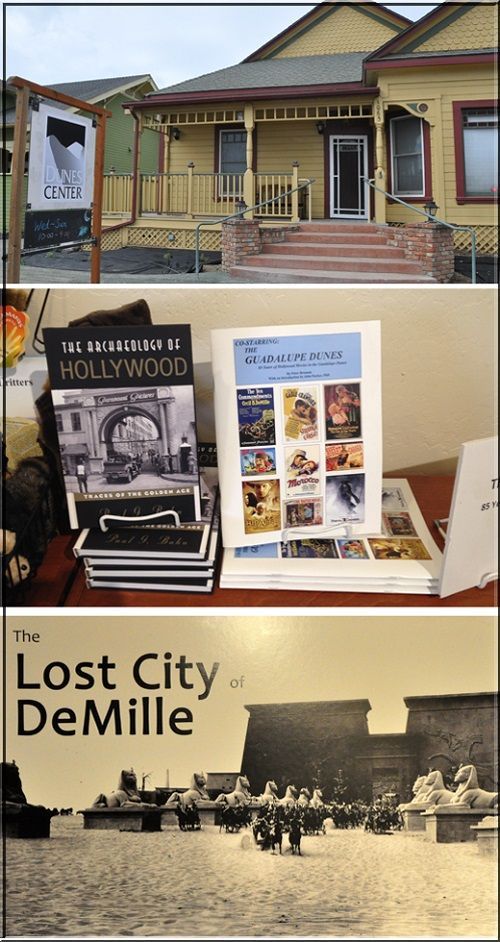
The Dunes Center is a simple structure. It does not look as if the community or the greats of Hollywood have spent much to develop it as an attraction yet it really is worth a visit.
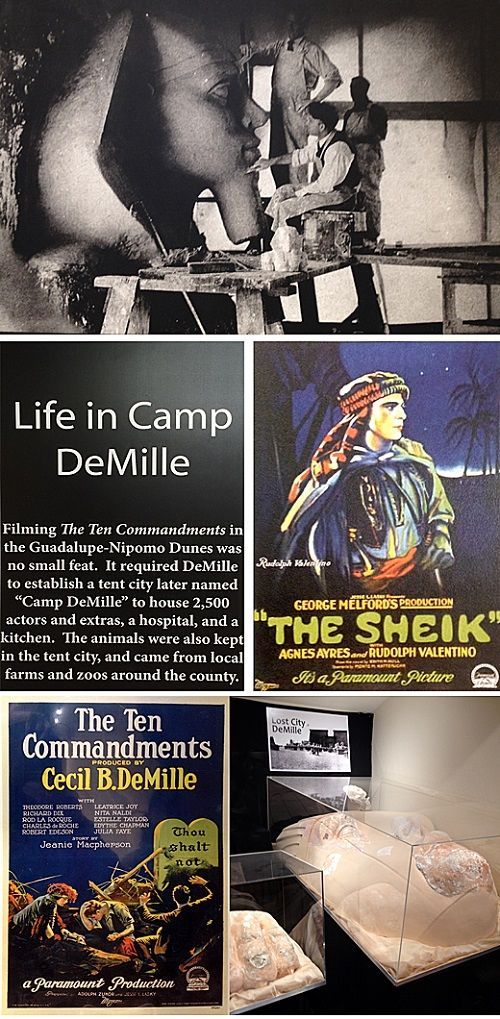
Some of the original documents and photographs of the 1923 movie are on display at the Dunes Center. The effort a producer had to put into a movie is spotlighted with this information about Camp DeMille. On the beach DeMille had 5,000 animals and they ate 20,000 lbs of hay a day. He had 3,500 actors who daily ate 5,000 oranges and 7,500 sandwiches (provided by 125 cooks). He used 1,500 construction workers who created one million pounds of statuary and built 300 chariots. Seventy-five miles of reinforcing cables were needed and 25,000 lbs of nails. No wonder DeMille didn’t want to take all this back to Paramount, the distributor.
One mile away the well preserved Southern Pacific train depot recalls an earlier era when the railroad tracks from San Luis Obispo reached Oceano in 1895. Before that the only access to the area was by wagon or stagecoach. The current depot was built in 1904 (after a fire destroyed the original the year before) and, after retirement from service in 1975, was moved 400 yards north to its present location and restored as a museum. Most of the restoration was done by local volunteers led by the late Harold Guiton when the community was allowed to buy the building for a dollar. Local train travel peaked in the 1920s then the advance of the automobile and the great Depression eroded the importance of the Oceano station.
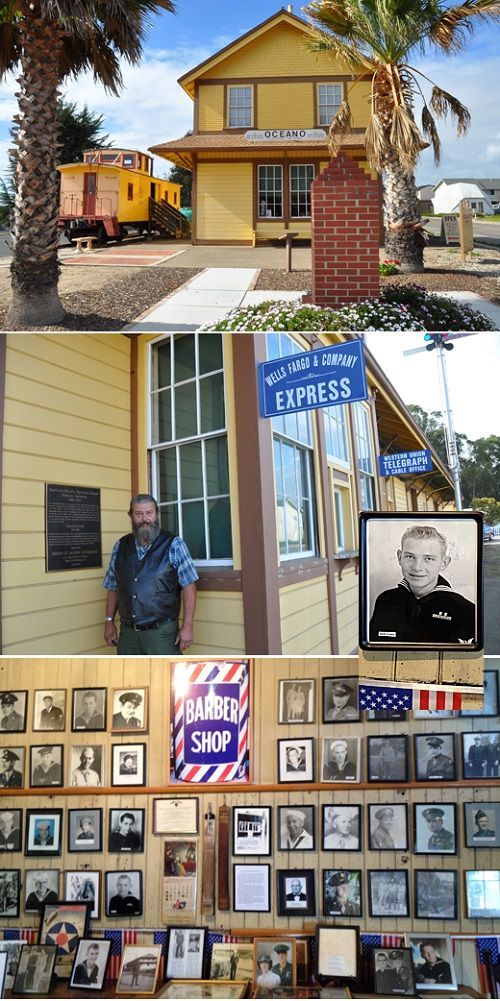
The train depot in Oceano was retired in 1975. Mark Weedon, the curator and a former dune rider. The photographs on display of local boys from World War II were exhibited when the son of a local barber enlisted in the US Navy and the father put up his photograph in his barber’s shop—and soon the collection grew.
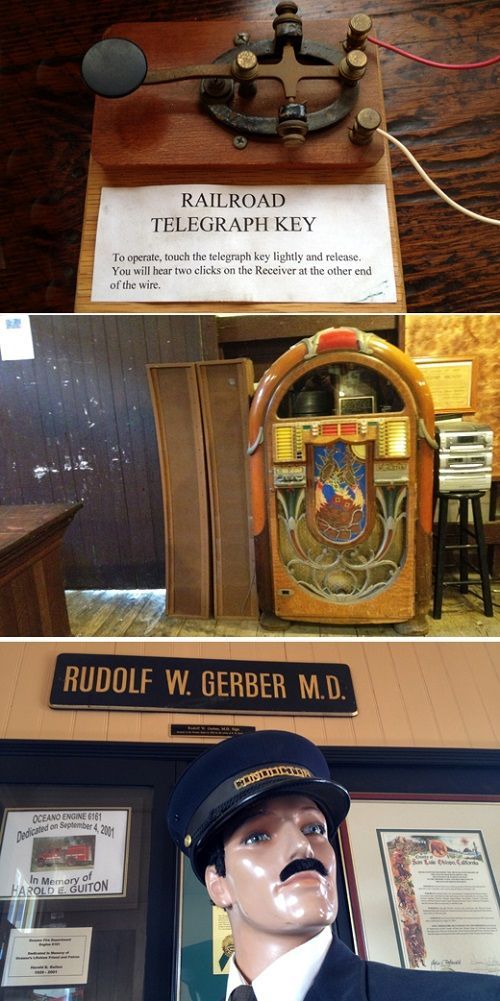
An antique telegraph key, a Wurlitzer juke box and a mannequin showing a railway porter grace the Oceano Train Depot and up on the wall hangs the former shingle of a popular local doctor: Rudolf W. Gerber, MD.
Dr. Gerber’s shingle meant a lot to the Oceano community. He was the first physician to reside in Oceano and when he arrived much of town had no electricity. “During those early days he kept a lantern lit at night so people could find the way to his door.” In the Depression like many physicians he did not demand payment for his services; it was said “he would trade clams for stitches.” He died in 1992 aged 90.
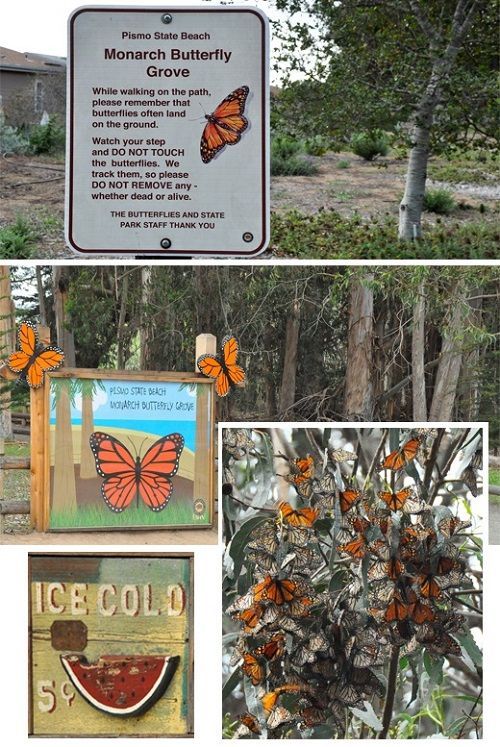
A seasonal attraction at Pismo State Beach is the Monarch Butterfly migration from late October to February involving a colony of about 25,000 monarchs of the type with a 6-month life span (greater than the usual 6 weeks the common Monarch has, yet “despite that extended life span those Monarchs who leave in March will never return.”) Their descendants cluster in the same eucalyptus trees every year returning annually because of their genetic homing systems that scientists don’t really understand. Monarchs east of the Rocky Mountains winter in Mexico; west of the Rockies they head for many roost sites along the Californian coast. If you come in season and want to take photographs be sure and bring a long lens! Don’t expect a slice of water melon for 5 cents; it’s an antique sign in a long-time summer resort!
The fundamental tourist attraction in Pismo is its beach. The Pacific Ocean is what, of course, gives the Californian coastal towns their identity and their economy. It took time for this to become apparent in Pismo. Jose Ortega received the land as part of a grant from the governor of Mexico in 1840. Parts of the land grant were subsequently purchased by ranchers including John Michael Price who bought his portion with 477 head of cattle. Price built a hotel along the highway in 1875. It failed. He then had the wisdom to move the hotel to the beach in 1884 and a community called El Pismo was born.
Photography by the authors
The Andersons, who live in San Diego, are the resident travel & cruise columnists for Physician's Money Digest. Nancy is a former nursing educator, Eric a retired MD. The one-time president of the New Hampshire Academy of Family Physicians, Eric is the only physician in the Society of American Travel Writers. He has also written 5 books, the last called The Man Who Cried Orange: Stories from a Doctor's Life.
